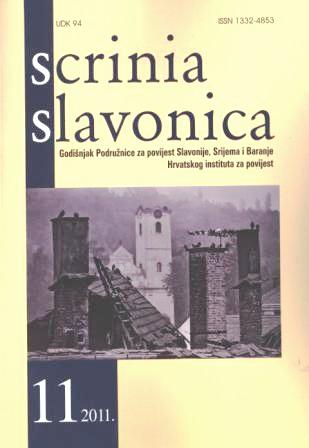Srpska oblast Istočna Slavonija, Baranja i Zapadni Srijem – od “Oluje” do dovršetka mirne reintegracije hrvatskog Podunavlja (prvi dio)
The Serb district of Eastern Slavonia, Baranja and Western Syrmia – from the Croatian operation “Storm” to the completion of the peaceful
Author(s): Nikica BarićSubject(s): History
Published by: Hrvatski institut za povijest
Keywords: Serb District of Eastern Slavonia; Baranja and Western Syrmia; Syrmia-Baranja District; Joint Council of Municipalities; Independent Democratic Serb Party; Erdut Agreement; UNTAES; Croatian Danube Region
Summary/Abstract: The Serb District of Eastern Slavonia, Baranja and Western Syrmia (for a period of time it was also called Syrmia-Baranja District) was part of the self-proclaimed Republic of Serbian Krajina (RSK) that was established in late 1991, after the aggression of the Yugoslav People’s Army and rebel Croatian ethnic Serbs on Republic of Croatia. In 1995 Croatia retook all western parts of RSK by military force and reestablished its authority over these areas. In November 1995 Croatian government and local Serbs signed the Erdut Agreement. Its basic tenet was the establishment of the transitional United Nations administration in the District and its gradual and peaceful reintegration into the Republic of Croatia. These goals were successfully achieved by early 1998. The article tries to present the process of peaceful reintegration from the perspective of the local Serbs. The paper is mainly based on Vukovarske novine newspaper, published by Serb Information centre in Vukovar. Its articles contain valuable information on the organization and activities of Serb District’s institutions such as District’s assembly and executive council as well as political organization and goals of the District’s Serbs. The first important task of the United Nations transitional administration was the demilitarization of the District. Heavy weapons and equipment of the 11th Corps of Serb Army of Krajina were withdrawn to Yugoslavia. Local elections in the District were held in April 1997. Before the elections all political parties that existed during RSK agreed to join the new party - Independent Democratic Serb Party. After the elections institutions of the Serb District ceased to exist and were replaced by new municipal and city councils. Serb representatives were also elected to assemblies of Croatian Osijek-Baranja and Vukovar-Srijem counties. Croatian authorities also agreed to appoint Serb representatives from eastern Slavonia and Baranja to Croatian state ministries. During the process of peaceful reintegration Serbs unsuccessfully attempted to retain territorial autonomy of the District or to reorganize district into a new Croatia county. Instead they formed Joint council of municipalities, whose creation was included in the Erdut Agreement. Joint council of municipalities did not have executive powers but it served as a body that represented Serbs from eastern Slavonia, Baranja and western Syrmia toward Croatian authorities.
Journal: Scrinia Slavonica
- Issue Year: 2011
- Issue No: 11
- Page Range: 393-454
- Page Count: 62
- Language: Croatian

